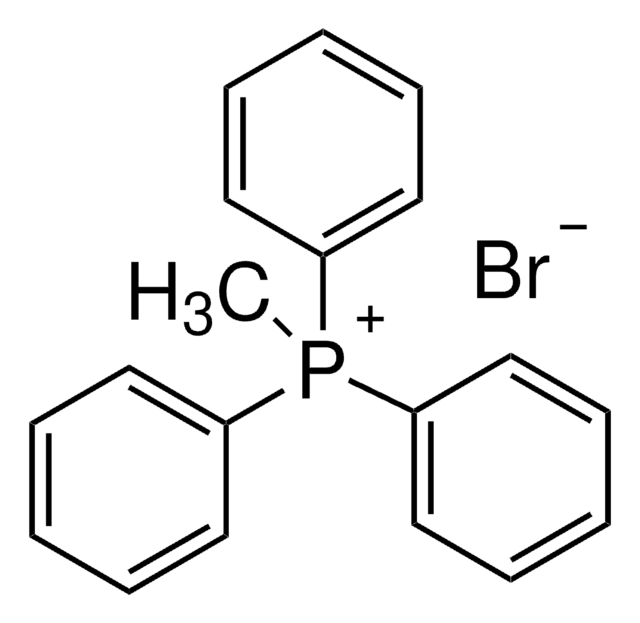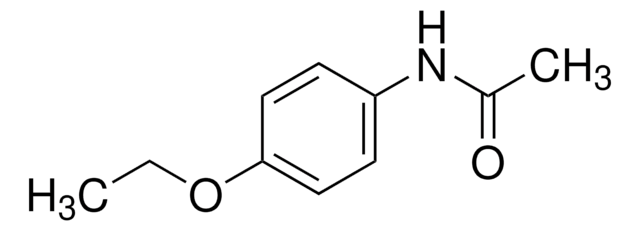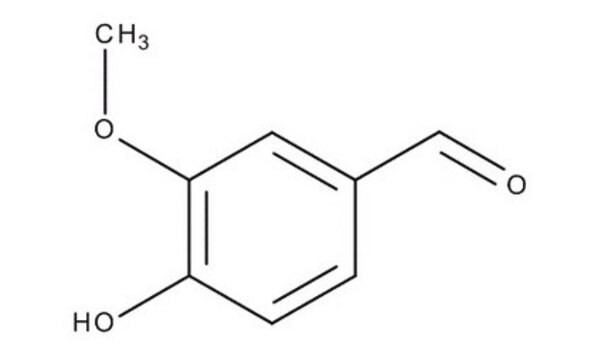77634
Vanillina
traceable to primary standards (LGC)
Sinonimo/i:
4-idrossi-3-metossibenzaldeide, Aldeide vanillica
About This Item
Prodotti consigliati
Grado
analytical standard
Livello qualitativo
Densità del vapore
5.3 (vs air)
Tensione di vapore
>0.01 mmHg ( 25 °C)
Qualità
traceable to primary standards (LGC)
Durata
limited shelf life, expiry date on the label
P. eboll.
170 °C/15 mmHg (lit.)
Punto di fusione
81-83 °C (lit.)
applicazioni
food and beverages
pharmaceutical
Formato
neat
Stringa SMILE
COc1cc(C=O)ccc1O
InChI
1S/C8H8O3/c1-11-8-4-6(5-9)2-3-7(8)10/h2-5,10H,1H3
MWOOGOJBHIARFG-UHFFFAOYSA-N
Cerchi prodotti simili? Visita Guida al confronto tra prodotti
Descrizione generale
Mettler-Toledo calibration substance ME 51143093, vanillin is an analytical standard for use in the regular checking of Mettler-Toledo melting point instrument. Its value equals an average of 6 to 12 measurements with a Mettler-Toledo MP90 Excellence instrument that is calibrated against primary standards. The melting point is validated by Capillary method according to European Pharmacopeia (2.2.14.)
Applicazioni
Caratteristiche e vantaggi
- Traceable to a primary standard (LGC, London)
- Melting point evaluation conducted in both thermodynamic and pharmacopeia modes for physically correct and heating rate dependent melting point determinations, respectively
- Provided with certificates of analysis and safety data sheet
- A product of analytical standard grade to help meet the QC/QA requirements of melting point determination
- Standard deviation up to ± 0.2 °C
Prodotti consigliati
Note legali
Avvertenze
Warning
Indicazioni di pericolo
Consigli di prudenza
Classi di pericolo
Eye Irrit. 2
Codice della classe di stoccaggio
11 - Combustible Solids
Classe di pericolosità dell'acqua (WGK)
WGK 1
Punto d’infiammabilità (°F)
319.6 - 321.4 °F - closed cup
Punto d’infiammabilità (°C)
159.8 - 160.8 °C - closed cup
Dispositivi di protezione individuale
dust mask type N95 (US), Eyeshields, Gloves
Choose from one of the most recent versions:
Possiedi già questo prodotto?
I documenti relativi ai prodotti acquistati recentemente sono disponibili nell’Archivio dei documenti.
I clienti hanno visto anche
Il team dei nostri ricercatori vanta grande esperienza in tutte le aree della ricerca quali Life Science, scienza dei materiali, sintesi chimica, cromatografia, discipline analitiche, ecc..
Contatta l'Assistenza Tecnica.













